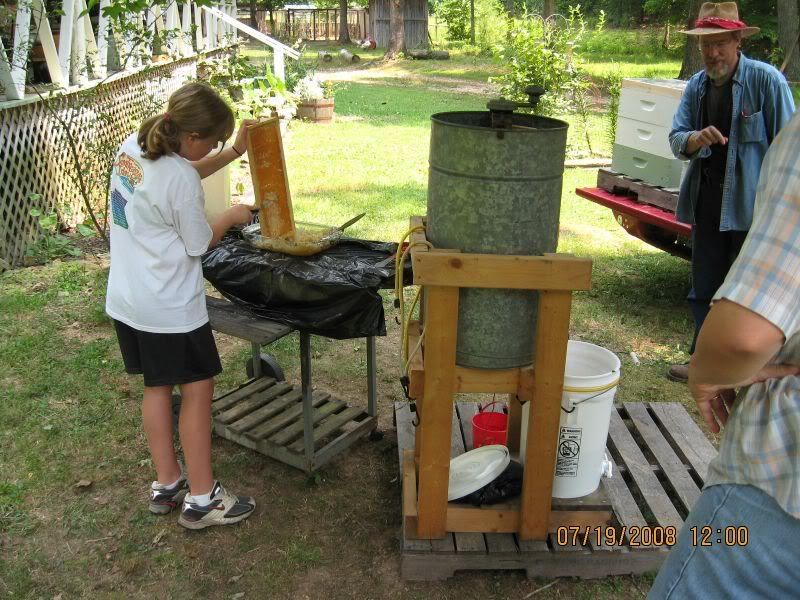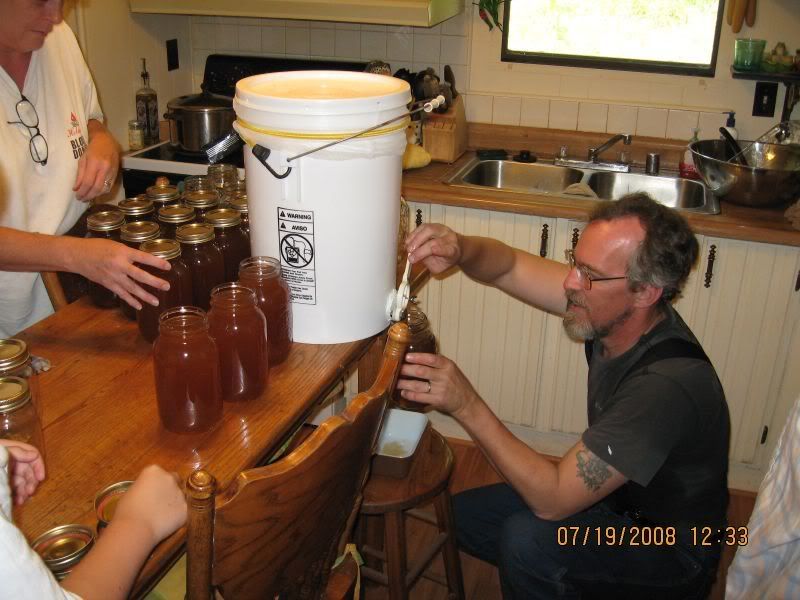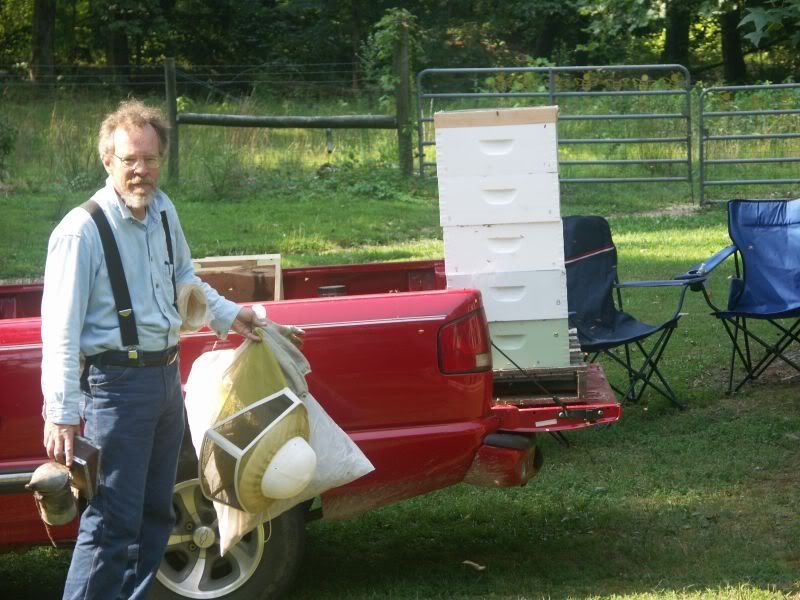This morning we started harvesting honey. We pulled 5 supers off the two langstroth hives – we haven’t even looked at the top bar hives yet. It took about an hour to sort through frames and pull the supers. This year we used a fume board to clear the supers after they were pulled from the hive. I can’t recommend one enough to anybody working bees. It is a simple structure – a wooden frame with a cloth across the bottom. You squirt a liquid called bee-go, which smells like some sort of nail polish remover, on the cloth and place it on top of the super. The fumes from the liquid evaporating drive the bees from the frames without contaminating the contents. In the past I would smoke the bejabbers out of the frames and brush bees from them, but the results were not nearly as good and it took quite a bit of smoke and effort. With the bees evacuated from the supers, they can be handled without protective gear – a blessing on such a hot day. I threw a pallet in the back of the truck and loaded the supers when the bees cleared them. We drove the truck over to the area we had set up for decapping and extracting.
After pulling the supers, we went into town to pick up our blueberry order. We bought two gallons of blueberries and Karen is processed them for the freezer.
About 2 PM we went back outside and started extracting honey. By 4 PM we had 4 gallons of honey extracted and bottled. We seem to be getting a gallon for every three frames. We have a total of 39 frames, some of which will be processed as cut comb. The remainder will be bottled. For now the supers will sit on a pallet on the tailgate of the truck until we can resume work tomorrow. The extractor is covered with a new garbage bag and pulled tight with bungee cords to keep it from filling up with bees. The longer this stuff sits out, the more bees are attracted by the smell of the honey.
7/19
WRTN came over from Wayne county with his wife and one of their daughters. They just started bees this year and it will be their first harvest. This is a chance to get some hands-on experience before trying it on their own. I am surprised at how well the processing is going. We seem to have learned from last years mistakes and have gotten organized for this year. Last year we tried an electric decapping knife – no good. The honey would caramelize on the knife between cuts and it made a mess of the comb. This year we tried a capping scratcher – still too messy and too difficult to use. We have found that nothing works better than a cheap serrated steak knife.
(mozilla and firefox users right-click view image for larger picture)

The best improvement was Karen’s idea – she brought out a large bowl of soapy water with wash cloth and towel. It was most helpful to be able to wash hands between tasks, reducing the stickiness of tools and equipment. We processed 21 frames in the extractor and cut 6 frames of comb. The final tally was 11 gallons and 3 quarts of bottled honey and 18 boxes of cut comb.

We have a large amount of wax and heating it will allow the wax and honey to separate – perhaps giving us the last quart and making an even 12 gallons. We still have the top-bar hives to harvest, though I doubt we’ll see the amounts we got from the langstroth hives.
The first year I tried bees I was in my 30’s and used full sized supers. There were warnings about how heavy a full super was when loaded with capped comb, but I was young and stupid. We use the shorter Illinois supers now – about 2/3 the size of a full super. These were heavy enough that I had to take a break and get a drink before finishing the job. Sometimes I feel really old. Last year we put brackets on the supers to reduce the number of frames. This might sound counter productive, but in reality it actually improves the work. The frames contain thicker comb and result in no less volume of honey – perhaps they even increase the volume because there are less cappings. The comb is easier to decap when it is thicker and you have less frames to process. Needless to say, by the time we’re done, everything is sticky. Outside it isn’t much of a problem – the bees will clean up any spilled honey. Inside is a bit more of a problem and requires wiping down everything with hot soapy water. Door knobs from entering and exiting the house, the kitchen floor - virtually every counter space and horizontal surface between the staging area and processing area. This year we used a vinyl tablecloth on the dining room table – that made clean-up much simpler.
7/20
Today we had a commitment to be in Columbia, so the old frames and supers needed to be cleaned up this morning. After sitting on the truck for two days there were quite a few bees working the old frames and I had to dress in protective gear.

I don’t know if they would have gone defensive, as the would protecting a hive, but these foragers were going crazy with robbing behavior and I wanted to get the job done quickly. The supers were spread out on the pallet so none of them could tumble off, and the truck driven back to the bee yard. The langstroths had been left with frames missing, so the first job was to open the hives and replace those frames. They have been busy the last two days and all but completed the frames left behind. One hive had started filling the spaces of missing frames with bridge comb and drawing comb from the inner cover into these empty spaces. The super left on each hive was filled with empty comb and an additional super of empty comb was replaced on each hive. The remaining empty comb was left out where the bees could rob them and clean the equipment. The process took about an hour. I have run out of burlap, my favorite smoker fuel, so have been using old straw. It makes smoke and is easily lighted, but causes the smoker to burn extremely hot. One of the biggest surprises this morning was the chick waterer. Our processing area was next to a small pen where chicks are being kept between brooding and release to the flock. The foragers working the supers on the truck were also getting water from the chick waterer. This was no big deal, the chicks were having fun chasing and eating bees, but this morning I found their waterer completely empty. They should have had enough water for another day, at least.
This year’s honey has a darker color and stronger flavor than last year. For some reason the comb had a higher amount of pollen stashed in it. The pollen is kept in separate cells from the honey, but it is almost impossible to avoid it when decapping. The pollen is sticky and resists extraction – most of the cells remained full, but enough comes out to color and flavor the honey. It is not unpleasant, just different from last year’s crop. I have had very strong honey from other yards that was almost bitter, but this is not that bad. Personal taste accounts for some of it. Buckwheat and other honeys have a very strong flavor and are very popular with some people. I do not care for it and prefer the milder clover honey. We ran out of last year’s crop a month or two ago and are on our secong jar of purchased honey. The first jar we purchased was from the coop and it had a bitter taste. This is a good crop and will be fine for cooking and baking.
7/23
Got the last of the honey and bee gear out to the bee yard for the bees to pick clean. The extractor, bottling bucket, strainer and frames are all sitting on pallets in the bee yard, to keep the poultry from pcking bees off as they glean honey from the ear. As soon as the new burlap gets here we will be harvesting the top-bar hive. The comb, only supported on the top bar, will require different techniques for harvesting. As we have never done this before, we will blazing new territory. Rather than placing comb in a box and transporting it, I am more inclined to think of a bucket and spatula. The comb is just too fragile to be moved. The comb can’t be extracted because of the absence of the support of a four sided frame, so we will no doubt have to crush the comb in a colander.
We are getting a significant amount of wax, and should get a lot more from the top-bar. To separate wax from honey and other impurities, we bake the wax at a low heat in a 13x9 pyrex pan. The wax moves to the top and all other impurities settle to the bottom. When it cools, a sheet or cake of wax can be pulled from the top and the honey remaining can be strained. This honey gets labeled as stout because it has been heated a number of times. It is fine for cooking, baking or as a sweetener in coffee or other beverages, but we try to keep it separated from the pure, unheated honey. We collected about a gallon of this stout. But even so, impurities cling to the bottom of the cake has impurities clinging to it, some embedded in the wax when it hardens.
For making candles, we use a pyrex measuring cup in a pot of boiling water. Beeswax, like paraffin, is too flammable to melt without a double boiler. Even with repeated separations, there remains a sludge at the bottom of the pyrex cup of honey, bee parts, propolis and other impurities. Pure wax can be poured off the top of the cup, but the sludge accumulates in the bottom. Much of the honey has been removed, so this is primarily dead bees, propolis with a small amount of caramelized honey. Caramelized honey is toxic to bees, another reason to separate stout from pure honey, and the final sludge from the measuring cup is even more concentrated. So far I have not found a use for it. The next time we head out to town we will pick up a non-stick cupcake pan and use that to pour cakes of pure wax until we can get down to the sludge and remove it.
7/26
The cupcake tin works well for collecting wax. We have about a dozen cakes of good, clean wax. We have also been able to discard about 2 cups of sludge that started collecting since the last harvest. The wax melts, the impurities generally sink to the bottom (though I have found dead bees will float). Floating impurities, a minority, can be skimmed off with a fork. The impurities that sink can be further settled with hydrogen peroxide, but the peroxide is cold and starts hardening the wax. I have found that hot water, taken from the bath of the double boiler, will float the wax. This isn’t a perfect substitute – impurities that would sink in peroxide are buoyant in water. Still, with a reusable container to hold clean wax skimmed off the top, we are virtually eliminating undesirable impurities in the wax and concentrating the impurities in the sludge to the point where there is no regret in tossing the sludge.
Regards,
Pat

